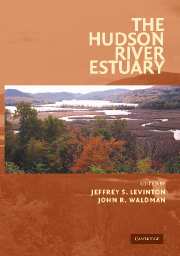Book contents
- Frontmatter
- Contents
- Preface
- List of Contributors
- The Hudson River Estuary
- 1 The Hudson River Estuary: Executive Summary
- GEOLOGICAL, PHYSICAL, AND CHEMICAL SETTING OF THE HUDSON
- PRIMARY PRODUCTION, MICROBIAL DYNAMICS, AND NUTRIENT DYNAMICS OF THE HUDSON
- HUDSON RIVER COMMUNITIES, FOOD WEBS, AND FISHERIES
- 12 Larval Migrations Between the Hudson River Estuary and New York Bight
- 13 The Diadromous Fish Fauna of the Hudson River: Life Histories, Conservation Concerns, and Research Avenues
- 14 Fisheries of the Hudson River Estuary
- 15 The Role of Tributaries in the Biology of Hudson River Fishes
- 16 Ecology of the Hudson River Zooplankton Community
- 17 Submersed Macrophyte Distribution and Function in the Tidal Freshwater Hudson River
- 18 Long-Term and Large-Scale Patterns in the Benthic Communities of New York Harbor
- 19 The Benthic Animal Communities of the Tidal-Freshwater Hudson River Estuary
- 20 Tidal Wetlands of the Hudson River Estuary
- 21 Alien Species in the Hudson River
- CONTAMINANTS AND MANAGEMENT ISSUES OF THE HUDSON RIVER ESTUARY
- Index
- Plate section
- References
19 - The Benthic Animal Communities of the Tidal-Freshwater Hudson River Estuary
Published online by Cambridge University Press: 06 January 2010
- Frontmatter
- Contents
- Preface
- List of Contributors
- The Hudson River Estuary
- 1 The Hudson River Estuary: Executive Summary
- GEOLOGICAL, PHYSICAL, AND CHEMICAL SETTING OF THE HUDSON
- PRIMARY PRODUCTION, MICROBIAL DYNAMICS, AND NUTRIENT DYNAMICS OF THE HUDSON
- HUDSON RIVER COMMUNITIES, FOOD WEBS, AND FISHERIES
- 12 Larval Migrations Between the Hudson River Estuary and New York Bight
- 13 The Diadromous Fish Fauna of the Hudson River: Life Histories, Conservation Concerns, and Research Avenues
- 14 Fisheries of the Hudson River Estuary
- 15 The Role of Tributaries in the Biology of Hudson River Fishes
- 16 Ecology of the Hudson River Zooplankton Community
- 17 Submersed Macrophyte Distribution and Function in the Tidal Freshwater Hudson River
- 18 Long-Term and Large-Scale Patterns in the Benthic Communities of New York Harbor
- 19 The Benthic Animal Communities of the Tidal-Freshwater Hudson River Estuary
- 20 Tidal Wetlands of the Hudson River Estuary
- 21 Alien Species in the Hudson River
- CONTAMINANTS AND MANAGEMENT ISSUES OF THE HUDSON RIVER ESTUARY
- Index
- Plate section
- References
Summary
abstract Benthic animals (those that live in or on sediments or vegetation) are of key importance in the Hudson River ecosystem. They are the major source of food to the Hudson's fish and regulate the abundance and composition of phytoplankton in the river. Benthic animals probably are important in mixing sediments, an activity that may affect the movement and ultimate fate of toxins in the river, although this process is not well studied in the Hudson. The benthic animal community of the Hudson is diverse, containing several hundred species of worms, mollusks, crustaceans, insects, and other invertebrates. These animals represent a wide array of life histories, feeding types, distributions, and adaptations. Community structure and population density vary greatly from place to place in the Hudson, and are determined chiefly by salinity, the presence of rooted plants, and the nature of the sediment (hard vs. soft). Nevertheless, a great deal of site-to-site variation in benthic community structure in the Hudson and other large rivers is unexplained. Human activities (especially water pollution and alteration of the channel for navigation) probably had large effects on the benthic communities of the Hudson, but these effects have not been well documented. The recent invasion of the Hudson by the zebra mussel (Dreissena polymorpha) profoundly changed the benthic communities of the river, altering their composition and function in the ecosystem.
- Type
- Chapter
- Information
- The Hudson River Estuary , pp. 266 - 278Publisher: Cambridge University PressPrint publication year: 2006
References
- 2
- Cited by



